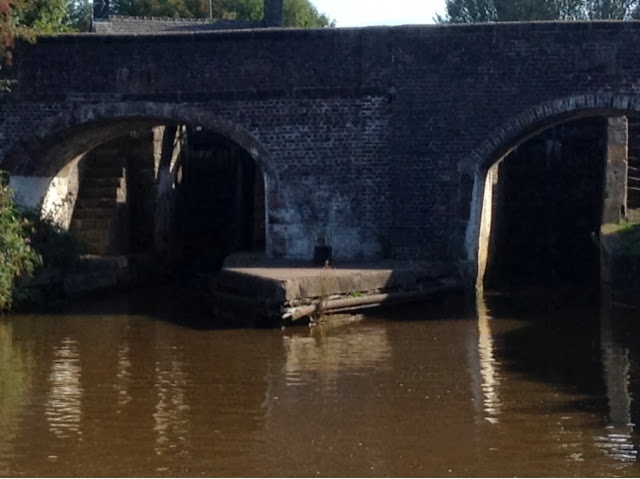Somehow we didn't want the trip to end and so were not pushing our speed as we made our way slowly down to Planet Lock (3 feet), and finally to the staircase at Bedford Street. I have mentioned this lock before this - a huge double staircase lock which lead into each other and, in our case, dropped us 19 feet down to the level of the Trent and Mersey.
At the bottom of the lock we stopped on the middle rope while John opened the weed trap to check the propeller as things were not sounding too good with the engine. John pulled oiut what looked like the remains of a bed sheet, a fabric handbag and a couple of long pieces of plastic. We can only think that we picked them up in the last stretch before the lock. The bed sheet makes a good starting point for a muder mystery!
The Caldon Canal winds round a small park just before the junction with the Trent and Mersey and in this park there is a statue of James Brindley with his surveying gear. I had to hop off the boat and run across the park, take the shot with both my Nikon and my iPad and then get back to the boat before it left the edge of the park. James would be terribly embarrassed at the state of his head and shoulders which looks like they are a favourite parking spot for the local pidgeons. As I took the photo I thanked James for his incredible legacy - a truly great man
Back on the boat, we joined the Trent and Mersey and arrived back at the Black Prince marina, tied up and the skipper called down to the engine room "Finished with engines". The voyage was done.
We reported in to the manager of the marina and told him that John and I would be sleeping the night on the boat. He was fine with that. We then asked him to take a photo of the "Three Men in a Boat", which he happily did, and I can show that we have made it through the voyage and are well and happy.
We walked into town to sort out cash and also for me to try to sort out Vodafone - without any success, though they did admit that thery needed to make sure their staff understood how to re-charge data on an iPad.
Back down to the marina for Stan to fetch his cases from the boat and then round to Toby's Carvery for a final meal together.
A taxi was called at the end of the meal and Stan set off on his return journey home.
John and I will tidy the boat tomorrow morning, pack our bags and make our way to Crewe for the night, before catching the train to Manchester Airport on Saturday morning.
We have had a great time together and I hope that you have enjoyed the trip with us.
Thanks for following!




































